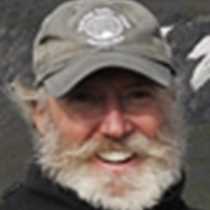Special Note: This week aboard the National Geographic Explorer, we are pleased to welcome the 2009 Grosvenor Teacher Fellows, select K-12 teachers from around the USA who have demonstrated excellence in geographic education. Click on the video above to see two of these Grosvenor Fellows, Mary Cahill and Lydia Lewis, venture into Arctic waters on a Zodiac, in search of a walrus haul-out. For more information on the Grosvenor Teacher Fellowship Program, please click here.
Hinlopen & Olga Straights
0615: “Good morning, good morning, we have a polar bear just ahead, please join us on the bow!”
I am not sure what brand of clock/radio alarm system you own or method you use to wake up in the morning…but I am sure it does not include an announcement of a polar bear sighting and an invitation to get up and view it.
Although most us had been up well past midnight with yesterday’s late bear sighting, we were back at it early this morning. This was another beautiful polar bear on the pack ice. In the vicinity were about 5 to 7 seals, all staying close to open leads for easy exit.
After a long satisfying look we moved a short distance away to a wondrous cliff area named Kapp Fanshawe. Kapp Fanshawe, with its fairy tale like spires and imposing cliff faces is the home to thousands of nesting sea birds, the most numerous being the thick billed murres or Brunnichs Guillemots….both names are correct.
The sight of these thousands of birds held us in awe, and then it became apparent that we were not the only ones interested in these birds. Just below the steep cliff faces lay a young polar bear, our second sighting of the day, all before lunch. Then, just a short distance away, an arctic fox also plied the base of the cliffs. Both of these predators were looking for the fallen egg or chick that had recently fallen from its nest. An easy meal here in the high arctic!
The afternoon found us further south in Nordaustlandet at place called Torellneset. Here we found a walrus haul out among beached ice bergs. The giants numbered over 20 animals. By using the icebergs as cover we were able to get a good close look. The vantage point also provided an excellent opportunity for photography.
As we returned to the ship, a thick fog enveloped the area making everything around us look as though the arctic had swallowed it.



